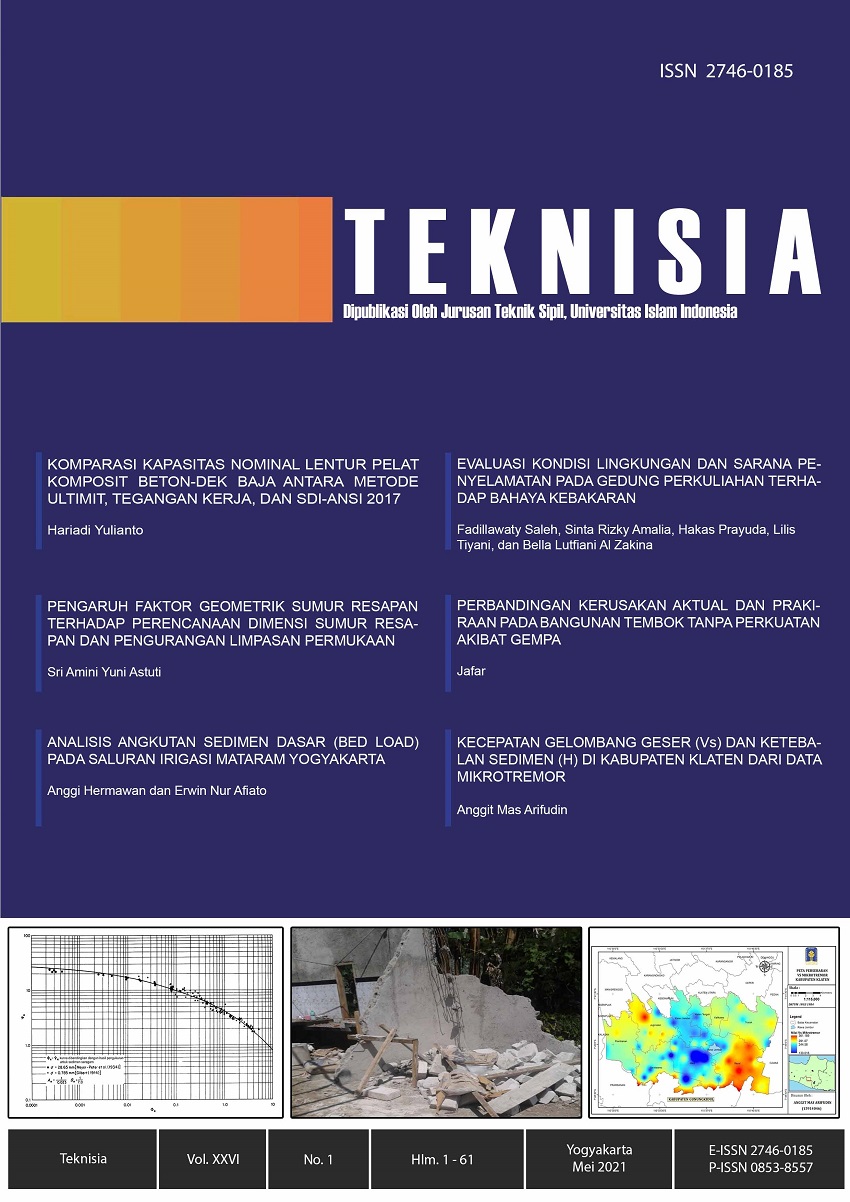Main Article Content
Abstract
Keywords
Article Details
Under the following term:
-
Attribution — You must give appropriate credit, provide a link to the license, and indicate if changes were made. You may do so in any reasonable manner, but not in any way that suggests the licensor endorses you or your use.
-
ShareAlike — If you remix, transform, or build upon the material, you must distribute your contributions under the same license as the original.
- No additional restrictions — You may not apply legal terms or technological measures that legally restrict others from doing anything the license permits.
References
- Amalia, Z., Huzaim, dan S, B. (2014). "Analisis Perilaku Pelat Komposit Floor Deck Beton Ringan Busa dengan kuat tekan 25 MPa, 30 MPa, dan 35 MPa". Tugas Akhir. Universitas Syah Kuala Darussalam.
- Blue Scope Lysagth Indonesia. (2008). "SMARTDEK". Blue Scope Lysagth Indonesia. Bekasi.
- Badan Standarisasi Nasional. (2019). "Persyaratan Beton Struktural untuk Bangunan Gedung SNI 2847-2019". Badan Standarisasi Nasional (BSN). Jakarta.
- Fastaria, R. dan Putri, Y. E. (2014). "Analisa Perbandingan Metode Halfslab dan Plat Komposit Bondek Pekerjaan Struktur Plat Lantai Proyek Pembangunan Apartement De Papilio Tamansari Surabaya". Jurnal Teknik ITS, Vol. 3, No. 2, pp. 41-46.
- Irnada, C. R., Huzaim, dan Bermansyah, S. (2014). "Analisis Perilaku Pelat Lantai Komposit Floor Deck Beton Ringan Busa Mutu 35 MPa dengan Ketebalan 10 cm, 12 Cm, dan 14 cm". Tugas Akhir. Universitas Syah Kuala Darussalam.
- Kadir, A. M. dan Sudarmadi. (2008). "Perilaku dan Kekuatan Pelat Lantai Komposit Beton-Metal Deck Terhadap Beban Lentur". Majalah Ilmiah BPPT M.P.I, Vol. 2, No. 3, pp. 232-240.
- Muliater, M., Tarigan, J., dan Roesyanto. (2018). "Analisis Lendutan dan Slip Pada Pelat Komposit Veton-Metal Deck Berdasarkan Perilaku Uji Statik". Konferensi Nasional Teknik Sipil 12, (hal. 155-164). Batam.
- Widhiawati, I. A. R., Yana, A. A., dan Asmara, A. A. (2010). "Analisa Biaya Pelaksanaan Antara Pelat Konvensional dan Sistem Pelat Menggunakan Metal Deck". Jurnal Ilmiah Teknik Sipil, Vol. 14, No. 1, pp. 20-27.
- SDI-ANSI. (2011). "C-2011- Standard For Composite Steel Floor Deck-Slabs". Steel Door Institute. Ohio.
- SDI-ANSI. (2017). "C-2017-2017 Standard For Composite Steel Floor Deck-Slabs". Steel Door Institute. Ohio.
- Segui, W. T. (2007). "Steel Design". Nelson. Toronto.
- Siregar, R. M. (2010). "Perbandingan Hasil Perancangan Pelat Beton Pracetak Dengan Pelat Beton Komposit Steel Deck Serta Tinjauan Balok Beton Pracetak Pada Gedung Rumah Sakit Akademik UGM". Program Swadaya Jurusan Teknik Sipil dan Lingkungan Fakultas Teknik UGM. Yogyakarta.
- Widjaja, B. R. (1997). "Analysis And Design of Steeldeck-Concrete Composite Slab". Virginia Polytechnic Institute and State University. Virginia.
References
Amalia, Z., Huzaim, dan S, B. (2014). "Analisis Perilaku Pelat Komposit Floor Deck Beton Ringan Busa dengan kuat tekan 25 MPa, 30 MPa, dan 35 MPa". Tugas Akhir. Universitas Syah Kuala Darussalam.
Blue Scope Lysagth Indonesia. (2008). "SMARTDEK". Blue Scope Lysagth Indonesia. Bekasi.
Badan Standarisasi Nasional. (2019). "Persyaratan Beton Struktural untuk Bangunan Gedung SNI 2847-2019". Badan Standarisasi Nasional (BSN). Jakarta.
Fastaria, R. dan Putri, Y. E. (2014). "Analisa Perbandingan Metode Halfslab dan Plat Komposit Bondek Pekerjaan Struktur Plat Lantai Proyek Pembangunan Apartement De Papilio Tamansari Surabaya". Jurnal Teknik ITS, Vol. 3, No. 2, pp. 41-46.
Irnada, C. R., Huzaim, dan Bermansyah, S. (2014). "Analisis Perilaku Pelat Lantai Komposit Floor Deck Beton Ringan Busa Mutu 35 MPa dengan Ketebalan 10 cm, 12 Cm, dan 14 cm". Tugas Akhir. Universitas Syah Kuala Darussalam.
Kadir, A. M. dan Sudarmadi. (2008). "Perilaku dan Kekuatan Pelat Lantai Komposit Beton-Metal Deck Terhadap Beban Lentur". Majalah Ilmiah BPPT M.P.I, Vol. 2, No. 3, pp. 232-240.
Muliater, M., Tarigan, J., dan Roesyanto. (2018). "Analisis Lendutan dan Slip Pada Pelat Komposit Veton-Metal Deck Berdasarkan Perilaku Uji Statik". Konferensi Nasional Teknik Sipil 12, (hal. 155-164). Batam.
Widhiawati, I. A. R., Yana, A. A., dan Asmara, A. A. (2010). "Analisa Biaya Pelaksanaan Antara Pelat Konvensional dan Sistem Pelat Menggunakan Metal Deck". Jurnal Ilmiah Teknik Sipil, Vol. 14, No. 1, pp. 20-27.
SDI-ANSI. (2011). "C-2011- Standard For Composite Steel Floor Deck-Slabs". Steel Door Institute. Ohio.
SDI-ANSI. (2017). "C-2017-2017 Standard For Composite Steel Floor Deck-Slabs". Steel Door Institute. Ohio.
Segui, W. T. (2007). "Steel Design". Nelson. Toronto.
Siregar, R. M. (2010). "Perbandingan Hasil Perancangan Pelat Beton Pracetak Dengan Pelat Beton Komposit Steel Deck Serta Tinjauan Balok Beton Pracetak Pada Gedung Rumah Sakit Akademik UGM". Program Swadaya Jurusan Teknik Sipil dan Lingkungan Fakultas Teknik UGM. Yogyakarta.
Widjaja, B. R. (1997). "Analysis And Design of Steeldeck-Concrete Composite Slab". Virginia Polytechnic Institute and State University. Virginia.
